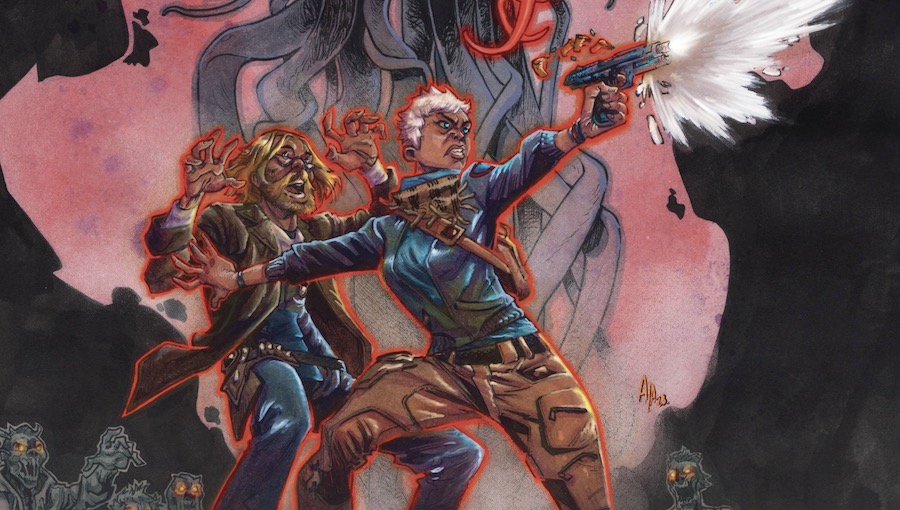The following is an interview with Michael Moreci, Alberto Jimenez Alburquerque, and Nate Piekos on the recent release of the comic book series, John Carpenter’s Toxic Commando: Rise of the Sludge God, through Dark Horse Comics and in collaboration with Saber Interactive and Focus Entertainment. In this interview, Fanbase Press Editor-in-Chief Barbra Dillon chats with Moreci, Alburquerque, and Piekos about their shared creative process in bringing the prequel story and characters to life on the page, the experience of adapting a known video game property to the sequential art medium, and more!
Barbra Dillon, Fanbase Press Editor-in-Chief: Congratulations on the release of John Carpenter’s Toxic Commando: Rise of the Sludge God! Michael, for those who may be unfamiliar, how would you describe the plot of this prequel series, leading up to the forthcoming John Carpenter’s Toxic Commando video game?
Michael Moreci: It’s a wild ride, as the title suggests! We’re digging into some very cool aspects of the game, tapping into the early (and more normal) days before everything goes to hell. We’re giving readers, and fans of the game, unique insight into the events leading up to the game’s narrative, introducing things like, as you might guess, the Sludge God! We had a bast working on this story—it’s one of those setups where you, as a writer, can really let loose.
BD: What can you tell us about your shared creative process in bringing this epic world of mutated monstrosities to life on the page?
MM: I was lucky to get a lot of help from the creative team behind the game. They’re the real geniuses here; the world they created, this story and these characters, is so rich, cool, and exciting, and it was a joy playing in their sandbox for a bit.
Alberto Jimenez Alburquerque: Having several groups of creatives working together may seem quite challenging at the beginning; however, everyone involved just chimed in to help and make the book better. The whole Saber team was really helpful with tons of references and really open to our ideas. The Dark Horse group, headed by Konner, was nothing but the best liaison team. And of course, Michael and I had already teamed up before, so it was all pretty seamless.
Hopefully, the result can be seen in the book.
BD: Adapting a prior work to a new medium can be a daunting process, especially in the instance of a video game, where its story may be told through a singular (or multiplayer) experience. What, if any, challenges did you experience in adapting this work in terms of its narrative and visual storytelling?
MM: For me, the biggest thing was doing justice to this really robust world that’s been created in the game. There’s so much going on—it’s one of those things where it feels very familiar yet totally unique, and when you get into that kind of situation you really have to maintain what’s come before you. My goal was to meet this game’s narrative at its level, and that level, being frank, is pretty high.
AJA: Videogames are really hard to match visually since they have the latest technology at their grasp and some of the best artists involved. So yes, it was quite challenging for me to pick up the pace and make justice to the amazing art in the game. Thankfully, the Saber team was always helpful and generous with their visual references and they have always been very supportive of my art. I’ve enjoyed drawing the amazing characters and environments of the game and tried to make them as impactful on the page as they are on screen.
BD: Nate, what can you tell us about your approach to the lettering of this series, and do you feel that the lettering style was intended to be unique from or complementary to the video game?
Nate Piekos: My process is to examine the art and do as much research on the subject as possible before designing a lettering style guide for the project. It’s an important part of my job to make sure the lettering marries well with the art. For instance, if the artist has a very painterly style, I lean towards sound effects and balloon strokes that are created with digital or conventional brushes. In this case, we have some pretty over-the-top artwork. Lots of fast-paced scenes. Lots of splattery zombie action! So, I’m making sure my lettering design is in your face without attracting too much attention away from the storytelling.
BD: In addition to your work on this series, are there any upcoming projects on which you are currently working that you would like to share with our readers?
NP: I do a lot of work for Dark Horse. Currently, I’m remastering all the lettering on Richard Corben’s DEN, I work on almost all the Stranger Things books…and quite a few projects I can’t talk about yet!
MM: I’ve always got Barbaric, that’s an evergreen project for me. I’m also writing Rick and Morty, and I’ve got a new movie—which I co-directed/wrote—called Holiday Hold-Up coming out later this year.
AJA: I’m currently finishing the six-issue series for Image Comics, The Bloody Dozen, with writer Charles Soule and an issue for Udon titled Darkstalkers: Jedah.
BD: Lastly, what is the best way for our readers to find more information about John Carpenter’s Toxic Commando: Rise of the Sludge God?
NP: Try to survive the video game!
AJA: Check the Dark Horse website and all their socials!

